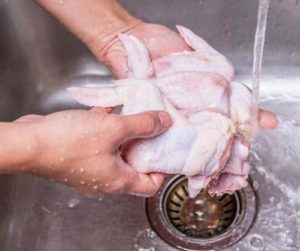 Q. When I buy chicken or meat, I like to wash it under cold running water before cooking. A friend of mine claims the chicken or meat must be washed in boiling water to clean it. Is one method better than the other? Is either necessary?
Q. When I buy chicken or meat, I like to wash it under cold running water before cooking. A friend of mine claims the chicken or meat must be washed in boiling water to clean it. Is one method better than the other? Is either necessary?
A. Not only is it not necessary to wash raw meat before cooking, it’s not a very good idea.
According to the USDA’s Food Safety Information Service:
Washing raw poultry, beef, pork, lamb, or veal before cooking it is not recommended…Some consumers think they are removing bacteria and making their meat or poultry safe. However, some of the bacteria are so tightly attached that you could not remove them no matter how many times you washed. But there are other types of bacteria that can be easily washed off and splashed on the surfaces of your kitchen. Failure to clean these contaminated areas can lead to food-borne illness. Cooking (baking, broiling, boiling, and grilling) to the right temperature kills the bacteria, so washing food is not necessary.
The article also has some useful food safety tips about brining meat, washing eggs, and cleaning raw produce.
- Brining: Keep raw meat in the fridge while soaking and take care not to let the brine splash onto other surfaces as it may harbor bacteria; wash brining vessel thoroughly after use.
- Eggs: Don’t wash them!
- Fruits and Vegetables: Wash with water and a brush; avoid vegetables soaps and detergents.
See also: How to Kill E. coli on Vegetables.
Thanks for the great question!



 Q. I tend to get food poisoning about once a year. Often, however, I am the only person in a group that gets it. Is there anything I can eat that would make my GI tract more resistant? Would probiotics help?
Q. I tend to get food poisoning about once a year. Often, however, I am the only person in a group that gets it. Is there anything I can eat that would make my GI tract more resistant? Would probiotics help? I was just reading a very interesting article on the safety of imported foods. Unfortunately, the publication (ADA Times) is for members of the
I was just reading a very interesting article on the safety of imported foods. Unfortunately, the publication (ADA Times) is for members of the 